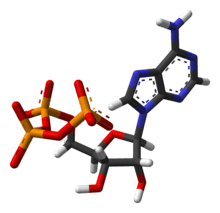Olga Kennard
Olga Kennard, née Weisz OBE FRS (born 23 March 1924) is a British scientist specialising in crystallography, and founder of the Cambridge Crystallographic Data Centre.
Olga Kennard | |
|---|---|
| Born | 23 March 1924 |
| Alma mater | Newnham College, Cambridge |
| Known for | Crystallography of organic molecules |
| Spouse(s) | Arnold Burgen |
| Awards | FRS, OBE |
| Scientific career | |
| Fields | Crystallography |
| Institutions | University of Cambridge, Cavendish Laboratory, Cambridge Crystallographic Data Centre |
Her research focused on determining the structures of organic molecules, including the first three dimensional structure of adenosine triphosphate[2] and particularly the different forms of DNA.[3]
Together with JD Bernal she believed in the value of collating scientific data in a central archive, this began the Cambridge Structural Database (CSD), collating crystal structures of mainly organic molecules. Kennard was also involved, at CSD, in the founding of the Protein Data Bank, and of the EMBL nucleotide sequence data library (later, European Nucleotide Archive).[4]
Early life and education
Kennard was born in Budapest, Hungary to Joir and Catherina Weisz,[5] moving to the UK at the age of 15 with her family in the face of growing antisemitism in Hungary. In the UK she was educated at Hove County School for Girls and Prince Henry VIII Grammar School, Evesham. She attended Newnham College Cambridge, studying Natural Sciences at a time when women did not formally receive a degree.[6][7] She went on to gain an MA in 1948 and DSc in 1973
Career

Following her studies, Kennard worked as a Research assistant at the Cavendish Laboratory, Cambridge from 1944–48, working with Max Perutz on the structure of hemoglobin.[8] After this she moved to London, working at the Medical Research Council RC Vision Research Unit from 1948-1951. In this role she studied rhodopsin and vitamin A with Hamilton Hartridge.[7] Subsequently, she was a research assistant, establishing a crystallographic lab at the MRC National Institute for Medical Research.[9] In 1961 Kennard returned to work in Cambridge (where she had lived whilst working in London) to the University's chemistry department to set up Crystallography Unit. She remained in this department until retirement.[7] During her career she has produced over 200 scientific papers and written several books.
Kennard is best known as a founder of the Cambridge Structural Database and first director (from 1965-1997) of the Cambridge Crystallographic Data Centre. The resource was borne of her belief that "collective use of data would lead to the discovery of new knowledge which transcends the results of individual experiments".[10]
Kennard held an MRC special appointment from 1974-1989 and was Visiting Professor at the University of London from 1988-1990.[6]
Honours and awards
She was elected a Fellow of the Royal Society in 1987[11] and awarded the OBE "For services to Scientific Research on the Structure of Biological Molecules" in 1988.[12] In recognition of her work, there is the Olga Kennard Research Fellowship in crystallography, administered by the Royal Society.[13]
In 1993 she was elected a member of the Academia Europaea.[14]
In 2003 the University of Cambridge made her a Doctor of Law honoris causa.[15]
In 2020, the IUCr awarded Dr Kennard the 12th Ewald Prize for her "invaluable pioneering contribution to the development of crystallographic databases".[16]
Personal life
She is married to Sir Arnold Burgen, her second husband; her first husband was David Kennard, to whom she was married from 1948-1961 having two daughters.[5] After retirement, Kennard was appointed as a trustee of the British Museum in 2004, a position held until 2012. She is an 'architecture aficionado' and lives in a Grade II listed house designed by Danish architect, Erik Sorensen.[17]
The National Portrait Gallery holds her portrait.[18]
Her niece is English actress Rachel Weisz.
References
- "The International Who's Who of Women 2002".
- Kennard, Olga; Isaacs, N. W.; Coppola, J. C.; Kirby, A. J.; Warren, Stuart; Motherwell, W. D. S.; Watson, D. G.; Wampler, D. L.; Chenery, D. H.; Larson, A. C.; Kerr, K. ANN; Sanseverino, L. Riva DI (1970). "Three dimensional structure of adenosine triphosphate". Nature. 225: 333–336. doi:10.1038/225333a0.
- Kennard, O; Hunter, WN (1989). "Oligonucleotide structure: a decade of results from single crystal X-ray diffraction studies". Q Rev Biophys. 22: 327–79. doi:10.1017/s0033583500002997. PMID 2695962.
- Kneale, G. G. (1984). "The EMBL nucleotide sequence data library" (PDF). Biochem Soc Trans. 12: 1011–1014. doi:10.1042/bst0121011. PMID 6530028.
- The International Who's Who of Women 2002. p. 292. ISBN 1857431227.
- Haines, Catharine M. C. International Women in Science: A Biographical Dictionary to 1950. ABC-CLIO. p. 157. Retrieved 7 January 2015.
olga kennard.
- Hargittai, Magdolna. Women Scientists: Reflections, Challenges, and Breaking Boundaries. p. 117. ISBN 0199359989.
- Perutz, M. F.; Weisz, Olga (1947). "Crystal Structure of Human Carboxyhæmoglobin". Nature. 160 (4075): 786–787. Bibcode:1947Natur.160..786P. doi:10.1038/160786a0. PMID 20272987. S2CID 4135217.
- Nash, Deborah. Women of Science: Righting the Record. Indiana University Press. p. 350. ISBN 9780253208132.
- Groom, CR; Bruno, IJ; Lightfoot, MP; Ward, SC (2016). "The Cambridge Structural Database". Acta Crystallogr B. 72: 171. doi:10.1107/S2052520616003954. PMC 4822653. PMID 27048719.
- "Olga Kennard Royal Society".
- "No. 51365". The London Gazette (Supplement). 10 June 1988. pp. 1–26.
- "Olga Kennard Research Fellowship Scheme". Retrieved 7 January 2015.
- "Olga Kennard". Academia Europaea. Archived from the original on 23 March 2020.
- "Honorary Degree Ceremony 2003".
- "Olga Kennard awarded twelfth Ewald Prize".
- Isaacson, Rivka (8 March 2017), "International Women's Day: meeting Olga Kennard", Times Higher Education, London
- "Olga Kennard (née Weisz) (Lady Burgen)".